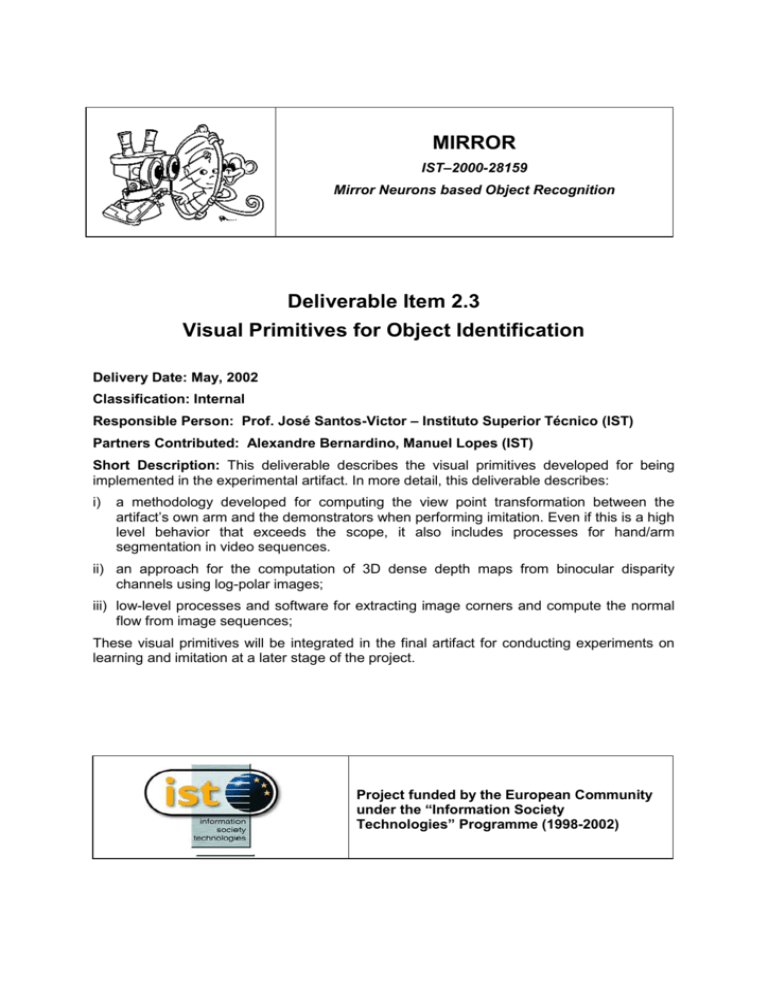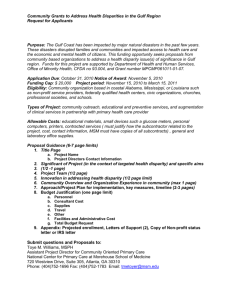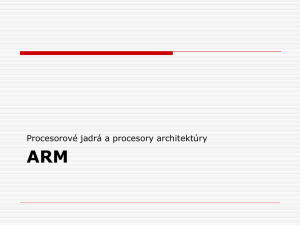DI-2.3 - LIRA-Lab
advertisement

MIRROR IST–2000-28159 Mirror Neurons based Object Recognition Deliverable Item 2.3 Visual Primitives for Object Identification Delivery Date: May, 2002 Classification: Internal Responsible Person: Prof. José Santos-Victor – Instituto Superior Técnico (IST) Partners Contributed: Alexandre Bernardino, Manuel Lopes (IST) Short Description: This deliverable describes the visual primitives developed for being implemented in the experimental artifact. In more detail, this deliverable describes: i) a methodology developed for computing the view point transformation between the artifact’s own arm and the demonstrators when performing imitation. Even if this is a high level behavior that exceeds the scope, it also includes processes for hand/arm segmentation in video sequences. ii) an approach for the computation of 3D dense depth maps from binocular disparity channels using log-polar images; iii) low-level processes and software for extracting image corners and compute the normal flow from image sequences; These visual primitives will be integrated in the final artifact for conducting experiments on learning and imitation at a later stage of the project. Project funded by the European Community under the “Information Society Technologies” Programme (1998-2002) IST-2000-28159 (MIRROR) October 30, 2002 Content list 1. 2. 3. 4. 5. Introduction ................................................................................................................... 2 Viewpoint Transformation and hand/harm segmentation ............................................... 2 Dense depth maps from binocular disparity channels .................................................... 3 Low-level image primitives ............................................................................................ 4 ANNEXES ..................................................................................................................... 5 Deliverable 2.3 1 IST-2000-28159 (MIRROR) October 30, 2002 1. Introduction The visual primitives described in this deliverable have been developed for different levels of application in the project, ranging from low-level feature extraction, including medium level 3D processing and figure-ground segmentation to the visual transformations involved in imitation and the required image processing tools for segmenting one’s arm/hand in an image/video sequence. Section 2 is devoted to the problem of imitating harm/hand gestures. One of the aspects considered is that of the Visual Transformation between the self-image when looking at one’s arm or that observed when looking at someone else’s body. In addition it describes the visual processing designed for segmenting one’s arm/hand in an image. Section 3 details how a 3D dense depth map can be obtained by utilizing a set of disparity channels computed from log-polar images. Section 4, describes briefly the low-level feature extraction processes that have been designed. It is of course expected that these Visual Primitives will evolve throughout the duration of the project either through adaptation to experimental needs or by including new Visual Primitives as necessary. 2. Viewpoint Transformation and hand/harm segmentation We have studied the overall problem of endowing an artifact with the capability to imitate someone’s gestures. Even if imitation is a high-level capability we describe this work in this report. The architecture is composed of two main blocks: a Sensory-Motor Map (SMM) and a View-Point Transformation (VPT) module. The sensory-motor map relates images of the arm to the required forces (or arm joint angles) that produce such an image configuration of the arm. It thus involves not only the arm (inverse) kinematics but also the camera geometry. It is learned during an initial stage where the robot performs random arm movements and uses the image observations to estimate the sensory-motor transformation. Once the SMM has been learned, the artifact is in theory able to generate the necessary arm torques or joint configurations to place the arm at a certain image posture. The SMM alone is not sufficient to allow the artifact to imitate the demonstrator’s gestures. In fact, the demonstrator gestures are imaged in a different position when compared to the artifact’s own arm, when performing the same gesture. This is illustrated in the figure on the left side, where both the arm of a teacher and that of a student perform similar gestures but they are perceived in very different image configurations, due to perspective. There is thus the need to transform the image of the demonstrator’s arm to a new configuration that corresponds to the image Deliverable 2.3 2 IST-2000-28159 (MIRROR) October 30, 2002 that the artifact would observe if its own arm were performing that same gesture. We refer to this process as the View Point transformation. Different classes of VPTs can be used depending on the task. The transformation can reproduce the full 3D transformation to align the demonstrator and the artifact’s bodies. However, in some other cases simpler geometric transformations suffice and this fact is vastly illustrated in experiments conducted with children or infants. Once the SMM and VPT have been defined and implemented, the system is able to observe the gestures of a demonstrator, transform the observed image to the so-called allo-image, as if observing its own arm and finally perform the gesture. In the example of the figure, the View Point Transformation would align the images of the teacher’s arm and that of the student. Another relevant aspect for the scope of this deliverable is the segmentation of the hand/arm of a demonstrator from images, as shown in the figure below. The process proposed is based on a colour segmentation scheme which is trained to distinguish skin-colour from other objects. Morphological filtering is applied to select large skin-coloured blobs. After normalization with respect to size and orientation, the extracted hand images are used in a classification methodology to recognize hand gestures. Even though encouraging results have been produced in real-time, additional work is needed to improve accuracy and robustness. Details of the entire methodology and experimental results are described in ANNEX I of this deliverable. 3. Dense depth maps from binocular disparity channels Foveation and stereopsis are important features on active vision systems. The former provides a wide field of view and high foveal resolution with low amounts of data, while the latter contributes to the acquisition of close range depth cues. The log-polar sampling has been proposed as an approximation to the foveated representation of the primate visual system. Although the huge amount of stereo algorithms proposed in the literature for conventional imaging geometries, very few are shown to work with foveated images sampled according to the log-polar transformation. Deliverable 2.3 3 IST-2000-28159 (MIRROR) October 30, 2002 We have developed a method to extract dense disparity maps in real-time from a pair of logmapped images, with direct application to active vision systems both for tracking or figure ground segmentation. The method we propose uses the gray/color values of each pixel directly, without requiring any further feature extraction, making this method particularly suited for non-cartesian geometries, where the scale of analysis depends greatly on the variable to estimate (disparity). The fact that we obtain dense information has makes it suitable for object segmentation and region of interest selection. The method starts by assuming a set of disparity hypotheses (mainly horizontal) and a probabilistic formulation is settled to determine the probability of observing a given disparity value at a given pixel subject to a disparity prior. The multiple hypotheses are then combined and the MAP estimate of the disparity computed. There are inhibition links between different disparity channels for the same pixel (i.e. one pixel can only have one disparity value) and reinforcement between similar disparity values associated to neighbouring pixels. Since the MAP is only computed after these processes, the resulting disparity field preserves depth discontinuities, thus being very appropriate for figure-ground segmentation. The picture above shows an example of one of the input images and the estimated disparity map. A detailed description and experimental results are included in ANNEX II. 4. Low-level image primitives The following Visual Primitives acting at the lower level of the processing chain of the final system have been developed: Log-Polar Mapping ActiveX Object (v2.0, 2002-10-25) - Allow to map Cartesian images to log-polar geometry. Various parameters of the log-polar map can be set using this software. Deliverable 2.3 4 IST-2000-28159 (MIRROR) October 30, 2002 Corner Detection ActiveX Object (v1.1, 2002-01-08) - Extracts corners from images. The process is based on the Harris corner detector. It starts by computing the matrix of second derivatives of the image (Hessian) and the lowest eigenvalue is selected to indicate the lowest spatial curvature of the image patch. This value must be above a threshold for the feature extractor to select a certain point. Corner Tracker ActiveX Object (v1.1, 2002-01-08) – Using the previous corner detector, this module tracks a corner over an image sequence by applying thewell-know Lucas-Kanade tracking algorithm. The algorithm is based on a first order approximation of an image pair and the optimal disparity is computed in a leastsquares sense. Normal Flow ActiveX Object (v1.0, 2002-03-28) – The normal flow corresponds to the projection of image motion on the direction of the image spatial gradient. It consists of the unique component of the image motion that can be computed locally, due to the well-known aperture problem. The normal flow is computed from spatio-temporal image derivatives. Log-Polar Warping ActiveX Object (v2.0, 2002-10-25) - This software is an implementation of the process described in Section 3 of this deliverable. A set of disparity hypotheses are used to generate warped versions of log-polar images that are used in a probabilistic framework to obtain a dense disparity map of the observed scene. 5. ANNEXES I - Visual Transformations in Gesture Imitation II - A Binocular Stereo Algorithm for Log-polar Foveated Systems Deliverable 2.3 5







